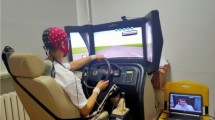Abstract
To model realistic driver behavior, research interest is growing to develop new approaches that deal with the integration of cognitive processing steps in order to tune the modeled behavior to be more humanlike. But what means humanlike in this context? This paper deals with the question: How brain dynamics can help to get insights into the internal processes preceding intended driver behavior? Features extracted from electroencephalography (EEG) data can serve as an indicator of such neural activities. This approach will be illustrated by two experiments, dealing with simple button presses and more complex realistic steering maneuvers in an obstacle avoidance task. We found the lateralized readiness potential (LRP) in both experiments preceding button presses (~200ms) and steering maneuvers (~190ms) as a valid neuronal characteristic for motor preparation processes. This data indicates, that a time range about 200ms should be considered between decide and action components to describe driver models more humanlike.
Chapter PDF
Similar content being viewed by others
Keywords
References
Bar-Gad, I., Bergman, H.: Stepping out of the box: information processing in the neural networks of the basal ganglia. Curr. Opin. Neurob 11(6), 689–695 (2001)
Platt, M.L.: Neural correlates of decisions. Curr. Opin. Neurobiol. 12(2), 141–148 (2002)
Gazzaniga, M.S., Ivry, R.B., Mangung, G.R.: Cognitive Neuroscience: The Biology of the mind. Norton & Company, New York (2002)
Wascher, E., Wauschkuhn, B.: The interaction of stimulus- and response-related processes measured by event-related lateralizations of the EEG. Electroencephal. Clin. Neurophysiol. 99, 149–162 (1996)
Jahanshahi, M., Hallett, M.: The Bereitschaftspotential: what does it measure and where does it come from? In: Jahanshahi, M., Hallett, M. (eds.) The Bereitschaftspotential. Movement-Related Cortical Potentials, vol. (1-18). Kluwer-Plenum, New York (2003)
Shibasaki, H., Hallett, M.: What is the Bereitschaftspotential? Clin. Neurophysiol. 117, 2341–2356 (2006)
Coles, M.G.H.: Modern mind-brain reading: Psychophysiology, physiology, and cognition. Psychophysiology 26, 251–269 (1989)
Hackley, S.A., Miller, J.: Response complexity and precue interval effects on the lateralized readiness potential. Psychophysiology 32, 230–241 (1995)
Prime, D.J., Ward, L.M.: Inhibition of return from stimulus to response. Psychol. Sci. 15(4), 272–276 (2004)
Haggard, P., Eimer, M.: On the Relation Between Brain Potentials and the Awareness of Voluntary Movements. Exp. Brain. Res. 126, 128–133 (1999)
Jasper, H.: Ten-twenty electrode system of the International Federation. Electroenceph. Clin. Neurophysiol. 10, 371–375 (1958)
Bell, A.J., Sejnowski, T.J.: An information-maximization approach to blind separation and blind deconvolution. Neur. Comput. 7(6), 1129–1159 (1995)
Delorme, A., Makeig, S.: EEGLAB: an open source tool box for analysis of single-trial EEG dynamics. J. Neurosci. Meth. 134, 9–21 (2004)
Lancaster, J.L., Rainey, L.H., Summerlin, J.L., Freitas, C.S., Fox, P.T., Evans, A.C., Toga, A.W., Mazziotta, J.C.: Automated labeling of the human brain: a preliminary report on the development and evaluation of a forward-transform method. Hum. Brain Mapp. 5(4), 238–242 (1997)
Lancaster, J.L., Woldorff, M.G., Parsons, L.M., Liotti, M., Freitas, C.S., Rainey, L., Kochunov, P.V., Nickerson, D., Mikiten, S.A., Fox, P.T.: Automated Talairach atlas labels for functional brain mapping. Hum. Brain Mapp. 10(3), 120–131 (2000)
Author information
Authors and Affiliations
Editor information
Editors and Affiliations
Rights and permissions
Copyright information
© 2011 Springer-Verlag Berlin Heidelberg
About this paper
Cite this paper
Welke, S., Protzak, J., Rötting, M., Jürgensohn, T. (2011). What Is Human? How the Analysis of Brain Dynamics Can Help to Improve and Validate Driver Models. In: Duffy, V.G. (eds) Digital Human Modeling. ICDHM 2011. Lecture Notes in Computer Science, vol 6777. Springer, Berlin, Heidelberg. https://doi.org/10.1007/978-3-642-21799-9_57
Download citation
DOI: https://doi.org/10.1007/978-3-642-21799-9_57
Publisher Name: Springer, Berlin, Heidelberg
Print ISBN: 978-3-642-21798-2
Online ISBN: 978-3-642-21799-9
eBook Packages: Computer ScienceComputer Science (R0)




